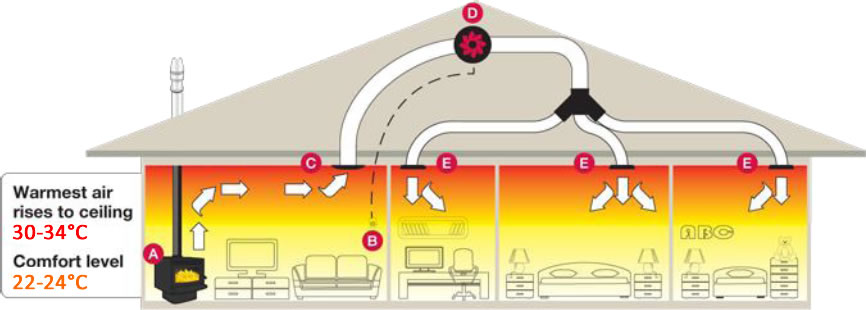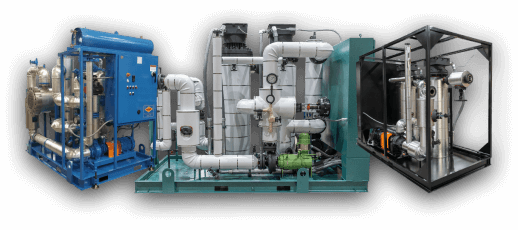How DVS Heat Transfer Systems Are Transforming Energy Efficiency in Industrial Cooling
The Function of Heat Transfer Systems in Sustainable Energy Solutions for the Future
Heat transfer systems are vital in the quest for lasting energy services. They maximize thermal energy monitoring, improving the effectiveness of renewable innovations. By using systems like transmission, radiation, and convection, these systems lessen energy losses. Their function in solar thermal and geothermal applications is especially substantial. As developments arise, the possibility for further developments increases important inquiries about future power approaches. What advancements will shape the landscape of lasting power?
Comprehending Heat Transfer Equipments

The Significance of Thermal Power Monitoring
Efficient thermal power management is essential for maximizing energy efficiency and lessening waste in numerous systems. By regulating temperature and enhancing Heat transfer procedures, companies can considerably reduce energy consumption and functional prices. Reliable management includes the execution of advanced modern technologies and techniques that keep track of and manage thermal problems within systems, making certain that power sources are used effectively. Additionally, correct thermal power monitoring contributes to decreasing greenhouse gas discharges, lining up with global sustainability goals. It also enhances system reliability and performance, resulting in improved product high quality and longer tools lifespan. Ultimately, prioritizing thermal energy management is a crucial action in the direction of producing much more lasting energy services and promoting an accountable approach to energy usage in commercial and residential contexts.
Applications of Heat Transfer in Renewable Resource
While numerous renewable resource resources promise sustainability, the effective application of Heat transfer plays a vital function in their efficiency. In wind energy systems, Heat transfer is made use of for generator element cooling, enhancing performance and durability. Geothermal power depends on reliable Heat exchange between the earth's subsurface and the liquid distributing in the system, optimizing energy extraction. Biomass power procedures also profit from Heat transfer, as it aids in transforming organic products right into usable gas through pyrolysis and gasification. Additionally, in hydropower, maintaining optimal temperatures in reservoirs can enhance energy result. Each of these applications demonstrates the vital significance of Heat transfer systems in boosting sustainable power modern technologies, eventually adding to a much more lasting energy future.
Enhancing Solar Thermal Power Performance
As solar thermal power systems remain to advance, improving their effectiveness has become important for taking full advantage of power outcome. Advancements in Heat transfer technologies, such as enhanced thermal storage products and cutting-edge Heat exchangers, play a significant function in boosting efficiency. By using innovative materials that have premium thermal conductivity, systems can transfer and catch Heat better. Furthermore, integrating radar that adhere to the sun's course assurances that collection agencies obtain suitable solar direct exposure throughout the day. Utilizing nanotechnology in solar absorbers can further boost power absorption rates. Furthermore, including computerized control systems helps take care of and manage temperature levels power distribution effectively, bring about minimized losses and boosted overall system effectiveness. These improvements lead the method for more sustainable solar thermal energy remedies in the future.
Geothermal Home Heating: A Sustainable Remedy
Geothermal home heating offers a viable choice for sustainable energy, providing significant environmental benefits via reduced greenhouse gas exhausts. Its performance and cost-effectiveness make it an appealing option to conventional furnace. Nevertheless, difficulties associated with application needs to be dealt with to maximize its prospective effect.
Ecological Benefits of Geothermal
Although conventional heating methods add considerably to greenhouse gas discharges, geothermal heating presents a compelling choice that reduces ecological effect. By taking advantage of the Earth's interior Heat, geothermal systems use a renewable resource resource, substantially minimizing dependence on fossil gas. This approach produces minimal carbon exhausts, making it a cleaner choice for business and residential home heating. Additionally, geothermal systems promote power performance, as they require much less power compared to traditional furnace. DVS Heat Transfer Systems. The utilization of geothermal energy additionally assists in minimizing air contamination, boosting regional air quality and public health and wellness. As a sustainable option, geothermal heating sustains environment change reduction initiatives, placing itself as an important element in the change in the direction of a greener future
Performance and Cost-Effectiveness
How does geothermal home heating measure up in regards to efficiency and cost-effectiveness compared to typical home heating systems? Geothermal home heating demonstrates premium effectiveness, often accomplishing a coefficient important source of performance (POLICE OFFICER) of 3 to 5, meaning it generates 3 to 5 systems of Heat for every single unit of power taken in. This efficiency converts into lower operating expense, particularly in regions with steady geothermal resources. Initial installment costs can be greater than conventional systems; nevertheless, lasting savings on power bills and reduced upkeep expenditures can counter these ahead of time financial investments. Furthermore, numerous federal governments incentivize geothermal systems through discounts and tax debts, boosting their cost-effectiveness. Generally, geothermal heating becomes a sustainable and economically viable option to even more standard heating services.
Application Challenges and Solutions
Various obstacles can restrain the widespread execution of geothermal heating unit, despite their clear benefits as a sustainable energy remedy. High first installation costs frequently hinder homeowners and financiers, making funding a considerable obstacle. In addition, the geographical limitations of appropriate geothermal sites restrict ease of access in certain regions. Regional guidelines and permitting processes can also complicate project growth, resulting in hold-ups. In addition, public awareness and understanding of geothermal systems stay low, preventing acceptance. To address these challenges, targeted education projects can boost public understanding, while government rewards might alleviate financial burdens. Collaborating with local authorities to improve policies may assist in smoother task authorizations, eventually advertising the adoption of geothermal heating as a feasible, lasting power choice.
Innovations in Heat Transfer Technologies
Innovations in Heat transfer modern technologies play a vital duty in enhancing power efficiency and sustainability. Advanced Heat exchangers and stage modification materials go to the center of these growths, supplying considerable improvements in thermal monitoring. These technologies not just optimize energy use yet also add to decreasing ecological impact in various applications.
Advanced Heat Exchangers
Advanced Heat exchangers play an essential duty in boosting power effectiveness throughout various applications in lasting energy remedies. These devices facilitate the transfer of Heat between 2 or even more fluids, significantly reducing power consumption in procedures such as commercial heating, cooling, and power generation. Advancements in materials and style, such as using nanofluids and portable setups, have actually resulted in boosted thermal performance and lowered size requirements. Furthermore, advancements in digital surveillance and control systems permit for optimized procedure, further boosting performance. By minimizing waste Heat and making the most of power recovery, advanced Heat exchangers add to lower carbon footprints and sustain the shift toward eco-friendly innovations. Their continued advancement is important for attaining international energy sustainability goals.
Phase Adjustment Products
The integration of phase adjustment products (PCMs) right into Heat transfer technologies represents a considerable innovation get redirected here in energy management and effectiveness. PCMs soak up and release thermal energy during their stage changes, making it possible for effective temperature policy in building materials and power systems. By storing excess Heat throughout optimal durations and releasing it when demand boosts, PCMs add to pack changing and energy conservation - DVS Heat Transfer Systems. This capability enhances the performance of sustainable energy systems, specifically in solar thermal applications. Additionally, PCMs can improve the thermal comfort of interior environments, reducing reliance on traditional heating and cooling methods. As advancements in PCM solutions proceed to arise, their function in sustainable energy solutions is poised to grow, offering promising opportunities for future research and application

Future Prospects for Heat Transfer in Sustainable Power
As the need for lasting power remedies remains to climb, the function of Heat transfer systems is ending up being increasingly essential in shaping future modern technologies. Innovations in materials and styles are anticipated to boost performance in Heat transfer, lowering energy losses in numerous applications. The assimilation of advanced thermal storage systems, such as phase modification products and thermochemical storage, will certainly enable better management of energy resources. Research right into nanofluids and biomimetic Heat exchangers may additionally enhance thermal performance. The adoption of smart technologies will allow for real-time monitoring and flexible control of Heat transfer procedures. These advancements are positioned to greatly add to the general effectiveness and sustainability of energy systems, leading the way for a much more energy-efficient future.
Often Asked Questions
How Can People Carry Out Heat Transfer Systems in the house?

Individuals can apply Heat transfer systems at home by installing energy-efficient devices, using radiant home heating, and optimizing insulation. These procedures enhance hop over to here power effectiveness, decrease prices, and advertise lasting methods in residential environments.

What Are the Prices Related To Installing Heat Transfer Systems?
The costs connected with installing Heat transfer systems vary widely, generally encompassing equipment, installation labor, and upkeep. Variables such as system type, home dimension, and local laws substantially affect the general expenditure involved.
Are There Government Motivations for Heat Transfer System Installations?
Government rewards for Heat transfer system setups differ by region and can include tax grants, refunds, and debts. These economic advantages intend to urge adoption, eventually promoting power efficiency and minimizing environmental influence within communities.
Just How Do Heat Transfer Equipments Effect Power Costs?
Heat transfer systems significantly influence power bills by maximizing energy performance. By enhancing the transfer of Heat, these systems decrease power usage, leading to reduced utility costs and producing a more sustainable approach to power management.
What Maintenance Is Needed for Heat Transfer Systems?
Upkeep for Heat transfer systems consists of routine examinations, cleaning of elements, inspecting liquid degrees, making certain appropriate insulation, and replacing worn components. These jobs help preserve efficiency, avoid malfunctions, and prolong the system's operational life expectancy.
These systems promote the movement of thermal energy from one tool to another, allowing the transfer of Heat for air conditioning, heating, or energy generation functions. Geothermal energy depends on reliable Heat exchange between the planet's subsurface and the fluid circulating in the system, maximizing energy extraction. Additionally, geothermal systems promote energy efficiency, as they require less energy compared to conventional home heating systems. Advanced Heat exchangers play a crucial function in boosting energy efficiency across various applications in lasting power options. Heat transfer systems especially affect energy bills by optimizing energy performance.